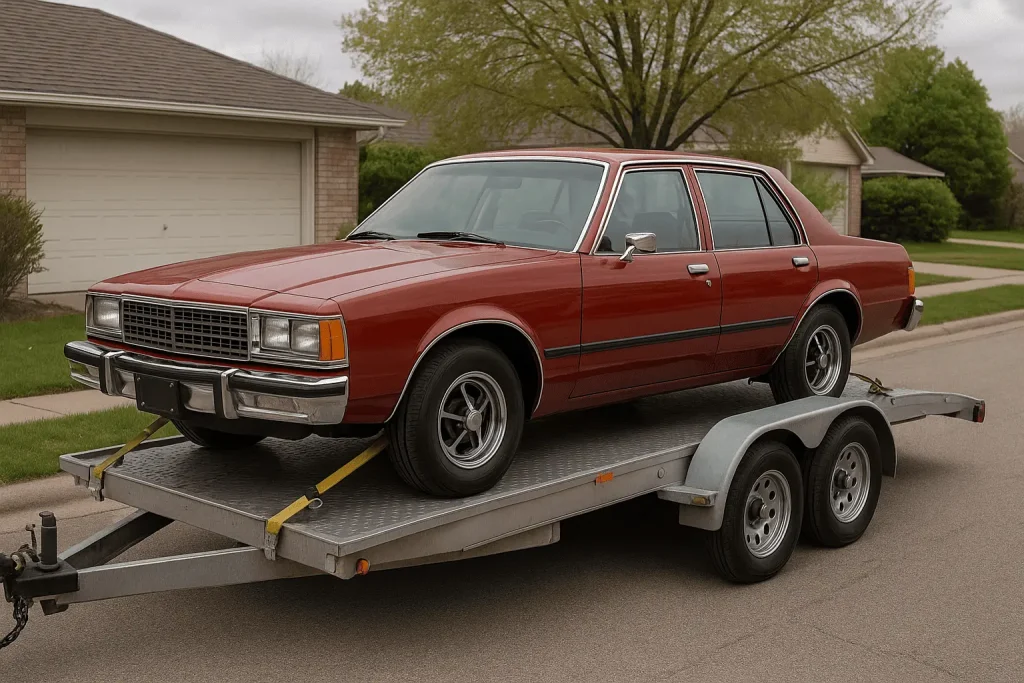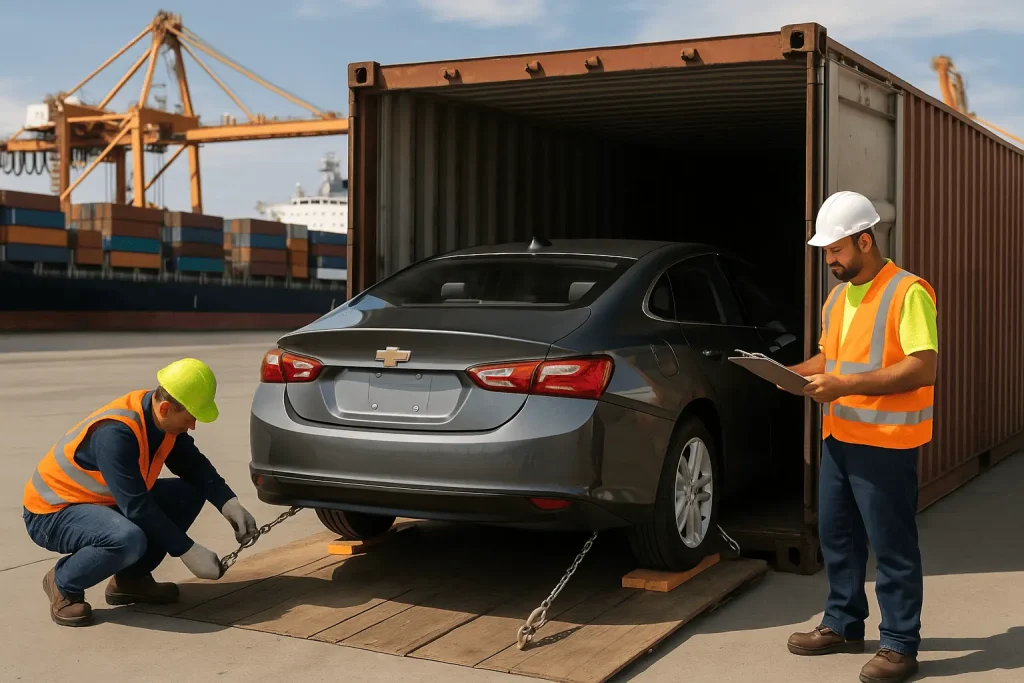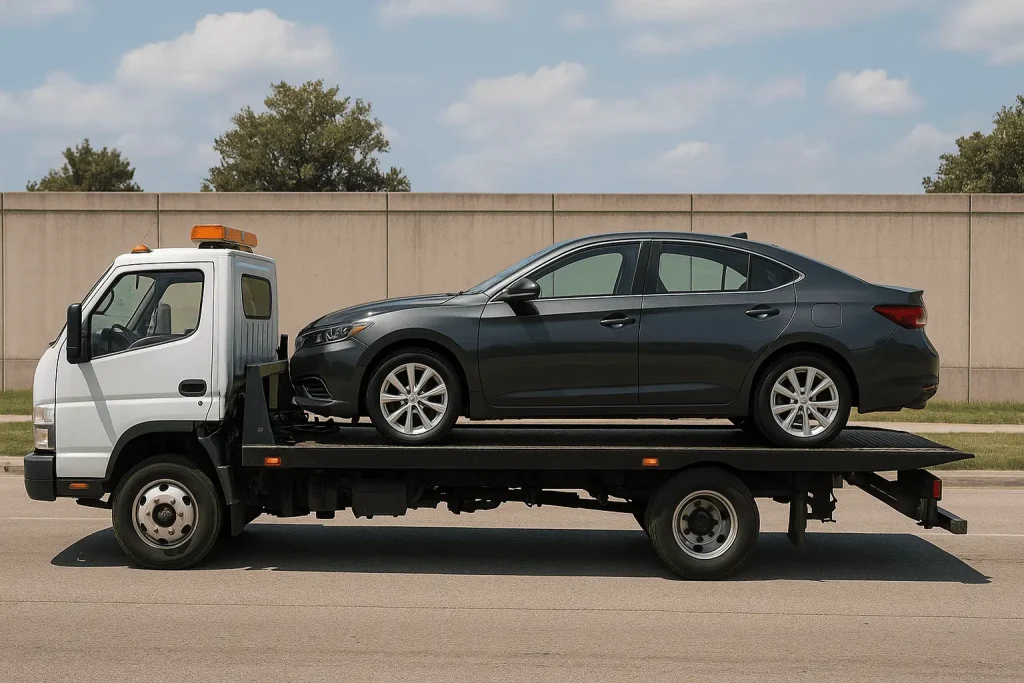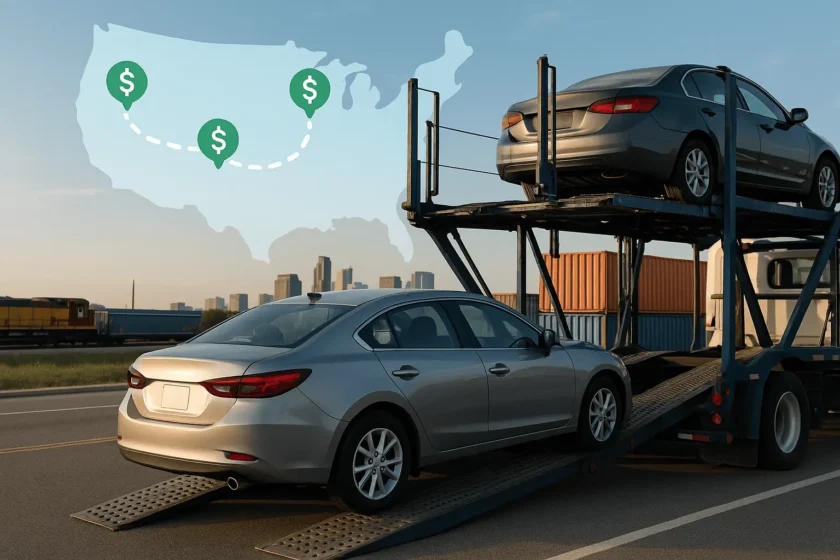When planning a cross-country move or sale, figuring out the cheapest way to ship your car can be a real headache. Between deciding which method to choose, calculating costs, and ensuring your vehicle arrives safely, shipping a car across the country poses a challenge for thousands of Americans every year.
Key Takeaways
- Open carrier transport is the way to ship a car. Multi-car trailers keep per-vehicle costs low, usually between $1,000 and $1,600 for a 2,000-mile trip.
- Prices depend on multiple factors like vehicle size, carrier type, distance, location, and timing all influence final quotes, with averages around $0.50–$0.70 per mile for open transport.
- Flatbed trucks, container shipping, and air freight serve special needs such as oversized vehicles, international moves, or urgent transport, but they are far more expensive.
- Smart planning lowers your shipping bill. Booking early, staying flexible on dates, shipping in off-peak months, and choosing terminal-to-terminal service can cut costs.
At its core, you might think the cheapest way to ship a car cross-country has to be by open carrier transport. This method uses the industry’s standard equipment, multi-car trailers that you see on highways every day, making it the most efficient and cost-effective option for the vast majority of vehicles. However, the “cheapest” method overall might not be the cheapest “for you” when all factors are considered.
In this definitive guide, we’ll break down all the available options from train shipping to their associated costs, and our top expert tips to ensure you save the maximum amount of money without compromising on the safety of your vehicle.
Top 7 Cross-Country Shipping Ways
There are multiple methods of cross-country shipping, and each comes with its own price point, advantages, and trade-offs. Understanding how each method works will make it much easier to decide which one is best for your specific situation. Below, we’ll break down each method in detail and discuss which is best for different scenarios.
1. Open Auto Transport
Open auto transport is by far the most popular and often the cheapest way to ship a car across the country. In this method, vehicles are loaded onto large, open trailers that can carry up to 10 cars at a time. Because carriers maximize efficiency by transporting multiple cars, the cost per vehicle is lower compared to other methods.

Cost: $1,000–$1,600
Time estimate: 7–10 days
Best for: If you’re shipping everyday vehicles, making a long-distance move, or just prioritizing a budget option.
| Pros | Cons |
| – It’s highly affordable and used by most major auto transport companies. – It’s a pretty safe method with a proven track record, as millions of vehicles are shipped this way yearly without any incidents. | – Your car is exposed to road debris and poor weather conditions. |
2. Enclosed Car Transport
Enclosed transport provides maximum protection by placing your car inside a covered trailer. It’s not the cheapest option, but it is a good choice for people with valuable or luxury vehicles that need extra care.

Cost: $1,800–$2,500
Time estimate: 7–12 days
Best for: Shipping classic cars, exotic supercars, high-value vehicles, and antiques.
| Pros | Cons |
| – This method offers added protection from harsh weather conditions and road debris. – It also offers an added layer of protection from prying eyes and potential theft. | – It costs 30-60% more than open carrier transport. – Its availability can be limited depending on the region you live in. |
3. Train Car Transport
Shipping by train can be one of the cheaper alternatives if you live near a rail terminal. Railroads have been moving vehicles for decades, so this option is still reliable for cross-country travel.

Cost: $800–$1,200
Time estimate: 8–14 days
Best for: Those who live near major rail hubs and have flexible timelines.
| Pros | Cons |
| – It can be cost-effective for very specific long-haul corridors as it’s a fuel-efficient method. | – Pickup and drop-off are very limited as you’ll have to get your car to and from a rail depot yourself. – It has limited availability and longer transit times due to fixed schedules. |
4. Driveaway Service
In this method, a professional or vetted driver physically drives your car to its destination. Some companies also partner with students or seasonal drivers looking for low-cost travel.

Cost: $800–$1,400
Time estimate: 5–7 days
Best for: Operational cars where added mileage is not a major concern.
| Pros | Cons |
| – Your car is not loaded onto a trailer, avoiding potential loading/unloading issues. | – It puts additional miles on your odometer. – This method relies on a single driver’s schedule. – It exposes your car to the wear and tear of a cross-country road trip. |
5. Drive or Tow Car Yourself
Driving your car yourself or towing it with a rental truck is usually the most budget-friendly method, if you’re willing to put in the effort. This method has long been the choice of students, small families, and those who want full control over the trip.

According to the U.S. Federal Highway Administration, the average light-duty vehicle travels about 12,000 to 14,000 miles each year. Driving your car across the country for a move could easily add 2,000 to 3,000 miles in one trip—roughly 15 to 25 percent of an entire year’s typical mileage—accelerating wear and increasing depreciation.
Cost: $700–$1,000
Time estimate: 4–6 days
Best for: Those who have the time and desire for a road trip or are already moving themselves.
| Pros | Cons |
| – You have maximum control over the schedule and process. | – Driving yourself is very costly in terms of time, fuel, hotels, food, and potential vehicle damage. – Towing requires specialized equipment and knowledge. – A cross-country trip can add hundreds of dollars in hidden costs. The average cost of owning and operating a new car is over $12,000 per year, or about $0.72 per mile when you consider depreciation, maintenance, and insurance. |
6. Container Car Shipping
Cars can also be loaded into shipping containers. This method is mainly used for international transport but is sometimes available domestically. It’s also rarely chosen within the U.S. due to its high cost, but it offers top-tier protection.

Cost: $2,000–$3,500
Time estimate: 10–15 days
Best for: Individuals relocating internationally. Container shipping is highly practical since it allows you to ship your vehicle alongside other household goods.
| Pros | Cons |
| – Excellent protection from the elements and security for your car. | – This method is one of the most expensive methods due to handling and container costs. – It can be overkill for domestic transport due to the relatively short distance. |
7. Flatbed Auto Transport
Single-vehicle flatbed trucks can be an option if you’re trying to ship oversized or specialty vehicles such as RVs, lifted trucks, or heavy machinery.

Cost: $1,500–$2,800
Time estimate: 5–10 days
Best for: Short-distance moves for inoperable vehicles or local towing.
| Pros | Cons |
| – It’s ideal as a dedicated service, as it doesn’t involve loading or unloading with other vehicles. | – Very expensive, as you are paying for the entire truck and driver for your one car. – It’s a low-availability method. |
Cross-Country Car Transport Prices
Car shipping prices might change based on market demand, vehicle characteristics, and even the season. For a standard, operable sedan using open transport on a popular route, you can expect a rough average of $0.50 to $0.70 per mile. A 2,000-mile trip could range from $1,000 to $1,400. Always get multiple quotes for your specific route from experts or use an auto transport quote calculator to understand the real-time market rate.
Let us do a quick review of these factors:
| Pricing Factor | Lower Prices | Higher Prices |
| The vehicle type | Smaller size and weighs less | Bigger size and weighs more |
| The carrier type | Open transport | Enclosed transport |
| Distance | Longer distance | Shorter distance |
| Location: near highway | Closer | Farther |
| Timeframe | Extended | Expedited |
| Vehicle condition | Operable | Inoperable |
Tips on How to Save Money on Car Shipping
If budget is your main concern, these strategies can help you bring costs down without cutting corners on safety:
- Book early: Avoid waiting until the last minute so you’re not forced to accept whatever is available at a premium rate. Advance scheduling gives you more carrier options and better prices.
- Be flexible with dates: If you can give carriers a larger time window for pickup and delivery, you’ll often get better deals. Carriers like to fill trailers efficiently, and flexibility helps them optimize routes.
- Choose terminal-to-terminal service: It saves money over door-to-door pickup and delivery because carriers don’t have to deviate from their main route. While it may require extra effort from you, it can shave significant dollars off your total cost.
- Ship in off-peak months: Winter and late fall often have lower rates due to reduced demand. By avoiding peak relocation seasons, you benefit from increased availability and competitive pricing.
- Ask about discounts: Many carriers offer student, military, first-time customer, senior citizen, or multi-car discounts. Don’t hesitate to ask about available discounts, as these promotions can lower your bill considerably.
- Prepare your car properly: When preparing your car for shipping, remove excess weight and personal belongings to lower fees. Clean your car inside and out to avoid inspection delays and to make existing damage easier to document.
- Negotiate: Some companies are open to price discussions, especially during slower seasons. Also, if you’ve gathered competing quotes, use them to your advantage when negotiating.
- Consolidate shipments: If relocating multiple vehicles, ship them together for volume discounts. Families moving more than one car or businesses moving fleets can save substantially by doing this.
Finding the cheapest way to ship your car cross-country depends on your budget, timeline, and comfort level with each method. For most people, open carrier transport is the best balance of affordability and convenience, while rail transport may be cheaper if accessible. And while DIY driving is technically the lowest cost, it adds personal effort, fuel expenses, and vehicle wear.
However, by planning ahead, comparing quotes, and staying flexible with your schedule, you can save hundreds of dollars on your car shipping journey. Remember that the cheapest option isn’t always the best. Factors like convenience, vehicle safety, and peace of mind also matter. With the right choice, you’ll have confidence knowing your vehicle is in good hands.
Frequently Asked Questions
What Is the Cheapest Way to Ship a Car Cross-Country?
The outright cheapest method is usually rail transport, if it’s available. However, open carrier transport is the best option for balancing cost and convenience. Driving yourself can also be the least expensive, but it comes with added time, wear, and personal costs.
What Are the Documents I Need to Ship a Car Cross-Country?
These are the documents you’ll typically need to ship your car: Vehicle registration, Proof of insurance, Photo ID, Signed bill of lading (provided by the carrier), Power of attorney (if someone else is handling the shipping on your behalf).
What Is the Cheapest Car Shipping Company?
There’s no one-size-fits-all answer here, as established carriers often provide competitive rates and benefits. The best approach to finding your ideal car shipping company is to compare quotes and check customer reviews. You should also make sure the company is licensed and bonded through the Federal Motor Carrier Safety Administration (FMCSA).
Can I Ship Personal Items in My Car?
Some carriers prohibit shipping your vehicle with personal belongings still inside, but container shipping may allow it. Always confirm with your provider, as additional weight can raise costs or void insurance coverage.
Sources
- “Annual Vehicle Miles of Travel (VMT) by Functional System.”. Federal Highway Administration. Accessed September 17, 2025.
- “AAA’s Your Driving Costs“. American Automobile Association (AAA). Accessed September 17, 2025.
- “Vehicle Delivery”. U.S. General Services Administration. Accessed September 17, 2025.






